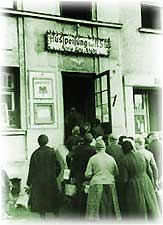Communal Social Policy 1938 - 1945
Brigitte Kepplinger

In 1938 the social security system was also fundamentally reformed. The guideline for all socio-political measures was the promotion of genetically healthy, Aryan and politically reliable people. Only these members of the Nazi society enjoyed state support. This strategy required a simultaneous labelling and exclusion of „inferior“, „non-Aryan“ and „politically or socially intolerable“ people.
The implementation of Nazi social policy invested great importance in the institutions of local social administration. It was their work that formed the basis for important decisions, such as for the withdrawal of child support or for the judgements of the courts assessing genetic health. The genetically healthy society was to be brought about by forced sterilisation, which was carried out at the General Hospital and the Women‘s Clinic.
The radical culmination of this concept was the „destruction of worthless life“, which was continued in individual psychiatric institutions after Action T4 was halted, among others in the sanatorium and nursing home Niedernhart, where hundreds of patients were killed by the Director Rudolf Lonauer between 1941 and 1944. It is worth noting the continuity in assessing and treating fringe groups, which was demonstrated by the work of communal welfare institutions, and can be traced back from the turn of the century up to the Second Republic.